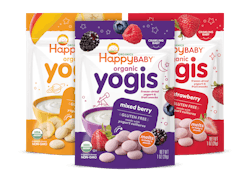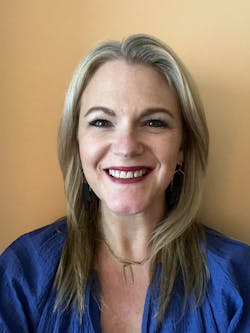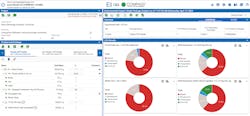Life-cycle assessment helps manufacturers weigh packaging options
By Karen Hanna
As a supplier of food for babies and young children, Happy Family Organics is expected to take the utmost concern for the health of its customers.
But its priorities also include the packages that contain its oatmeal, pureed fruit, vegetable crisps and other munchables for toddlers. About three years ago, it pledged to make all its packages reusable, recyclable or compostable by 2025.
“However, the path to recyclability isn’t as simple as designing packaging to be recycled. It also requires systemic change to address adequate access to recycling as well as infrastructure challenges that prevent recyclable materials from being recycled in practice and at scale,” said Marcu Alexander, packaging sustainability manager for Happy Family.
To work toward its goals, Happy Family has sought information from a source that is becoming increasingly popular in assessing a package’s sustainability — life-cycle assessments (LCAs) that take into account all facets of the package, from the resources used to produce it through the energy needed to dispose of it. People who study packaging say the analysis can go a long way toward determining what kind of package might be most appropriate.
Paper or plastic?
At a time when plastics have been demonized, the obvious choice isn’t necessarily the best, said experts who have studied issues surrounding packaging and waste.
“Attempting to switch into something like a glass package or cardboard package will almost always result in an inferior environmental outcome because they’re bulkier or they’re heavier,” said Calvin Lakhan, co-investigator of “The Waste Wiki” research project and a member of the faculty of environmental studies at York University in Toronto.
At least some studies conducted by Trayak, the life-cycle-assessment software company that’s worked with Happy Family, bear that out.
As part of one LCA, Trayak looked at the environmental impact of beverage bottles made from PET, glass, aluminum and coated cardboard.
PET won out, said Alison Younts, lead sustainability consultant for Trayak.
Images of plastic litter blighting wilderness areas might tell a different story, but Younts said the “emotional feel” of seeing plastic in the ocean isn’t the best barometer.
Often, plastics’ light weight makes it a better choice than any alternative, Younts and Lakhan said.
“We are seeing companies with some goals of getting out of plastic, but when we talk to them, we say, ‘No, plastic is not the enemy. It really can be a great material to efficiently and effectively protect your products, so that they’re not being damaged or spoiled,’ ” Younts said.
Freshness protectors
Sustainability is an ideal that encompasses concerns for social and economic factors, as well as for the environment — or “people, profit, planet,” as Younts refers to them. From the perspective of all three factors, it often presents many advantages, especially when used in packaging food or medical supplies, Lakhan said.
“A lot of the packaging helps maintain the safety and longevity of the product itself, and so COVID really reminded people of the role that plastics played,” Lakhan said.
Lakhan is a member of Sustainable Packaging Research, Information, and Networking Group (SPRING), a think tank of experts with backgrounds in packaging, materials science, recycling and other fields united by a desire for sustainable solutions.
Bob Lilienfeld, the group’s founder, has a simple test for evaluating a package: Does it work?
“There’s no such thing as a sustainable or an unsustainable package in and of itself. You’ve got to step back and say, ‘Why does the package exist?’ And the package exists to protect the products it contains,” Lilienfeld said.
Often, plastic is the best material for that job, said Lakhan, who is critical of the intricate supply networks that have created advantages for shipping items, including food, long distances rather than sourcing them locally.
People who are economically disadvantaged or live in remote places, such as areas of northern Canada, often don’t have good choices and can’t simply opt for fresher or “greener” alternatives, like the refillables that have become en vogue at some high-end shops, Lakhan said.
“The problem is we have broken food systems, broken consumption systems. In no way, shape or form should we be able to ship an apple from China to Canada in plastic wrap and have it be cheaper than just growing it locally,” he said. “... When I talk about a broken food system, which has resulted in a lot of [food] packaging, it’s what makes things affordable for a lot of families. ... I’ve done a lot of work in remote northern communities, and [food] packaging is vital to their everyday life.”
He worries about what crackdowns on plastic packaging might mean for society’s most vulnerable.
“Plastics plays such a vital role for affordable food, both amongst, once again, lower-income families, as well as those in remote or rural communities, and when we look at the net benefits of all of this — the increased shelf life, the product safety, the accessibility of food, the affordability of food — I think that, in my opinion, that when you weigh all those factors, that it’s of net benefit. It’s probably what I would characterize as a more sustainable option.”
Life-cycle look
Against the backdrop of what both Younts and Lakhan call the “war on plastics,” brand owners, along with their packaging suppliers, are turning to Trayak’s EcoImpact-Compass LCA software.
Over the years, Younts said, companies, especially brand owners, have changed their views on sustainability from a luxury to a must-have. Trayak software users now run the gamut, from boutique brands to big players.
“They are getting a lot of consumer feedback about packaging, which is great, which is driving a lot of conversations that honestly should have been had 10 years ago,” she said.
Created 12 years ago as part of a project of the Sustainable Packaging Coalition, Trayak’s software leverages U.S. Environmental Protection Agency data to evaluate how particular packaging designs impact issues such as emissions, and water and fossil-fuel use, Younts said. Among other factors, the software can help brand owners determine the manufacturing process that’s right for them.
Typically, Trayak’s customers have packaging designs in mind, but need quantifiable data to make informed decisions, Younts said.
“We’ll help them conduct the life-cycle assessment, getting all of the materials, the mass of those materials, the manufacturing process, and then the end-of-life considerations, we can also include transportation, if that’s going to be a difference between their suppliers, if they have to switch those,” Younts said.
In some cases, companies might opt for a package design that is tilted toward protecting one of Younts’ three P’s over another; when that happens, Trayak helps find a balance.
For instance, Younts said, brand owners that have committed to using post-consumer resin (PCR) could face economic obstacles.
“Is it really sustainable? If the company is able to eat that cost and not turn it toward the consumer, then maybe. But we also have to work together to make sure that we’re looking at end markets and increasing the value of PCR content, so that it’s more accessible,” she said.
Three tiers of optimization
With Trayak’s help, Happy Family cut down on the size of the pouches for its Happy Baby Yogis fruit snacks, Alexander said, and has evaluated its entire packaging portfolio. Shrinking the pouch brought another happy result — it allowed Happy Family to reduce the size of the cardboard cases used to pack the pouches, Alexander said.
In addition to their efficiency and cost, the new pouches won out from an emissions standpoint, Alexander said.
She praised Trayak for providing data in an approachable way.
“For example,” she said, “the annual reduction in [greenhouse-gas] emissions for reducing the packaging was 188,368 [kilograms of carbon-dioxide equivalent] which is equivalent to taking 40 passenger vehicles off the road for an entire year.”’
To recycle the fruit snack pouches and caps, Happy Family has partnered with TerraCycle, Alexander said.
Sometimes, Younts said, Trayak finds one packaging format is appropriate; other times, a different design makes more sense. It is not biased toward any material.
“There’s a reason that all these materials are on the market, because they have formats that they excel in,” Younts said, “And I think it’s really just about educating that there’s no enemy.”
Contact:
Trayak Inc., Mason, Ohio, 513-445-3264, https://trayak.com
Karen Hanna, senior staff reporter
About the Author
Karen Hanna
Senior Staff Reporter
Senior Staff Reporter Karen Hanna covers injection molding, molds and tooling, processors, workforce and other topics, and writes features including In Other Words and Problem Solved for Plastics Machinery & Manufacturing, Plastics Recycling and The Journal of Blow Molding. She has more than 15 years of experience in daily and magazine journalism.


